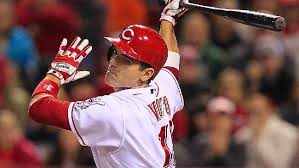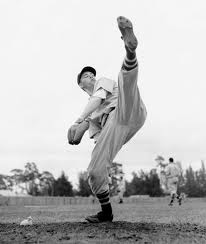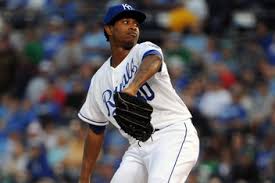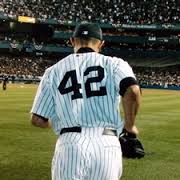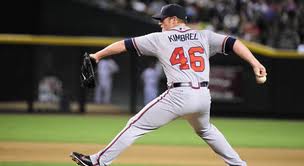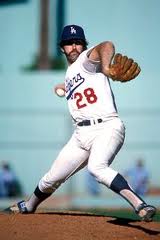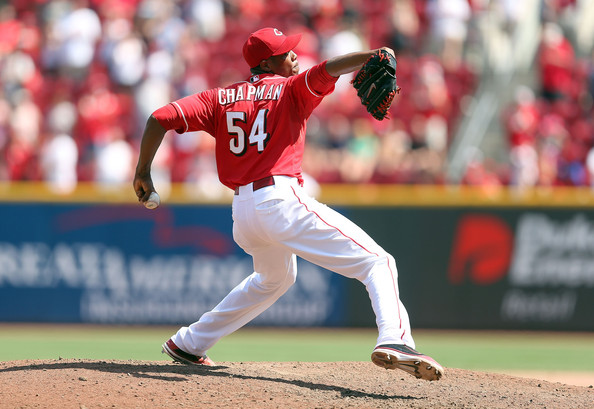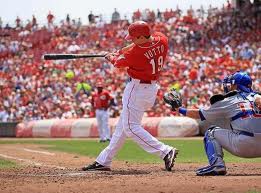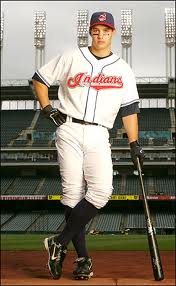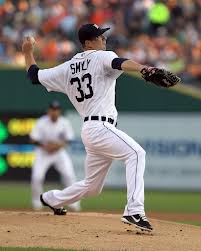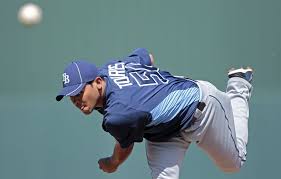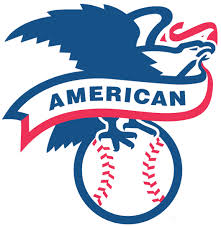Over the last nine games of the season, the Cincinnati Reds were 2-7, including their National League Wild Card loss in Pittsburgh, which would be their fifth loss against the Pirates in the nine game span. Needless to say, after a disappointing collapse in the 2012 National League Division Series against the San Francisco Giants, the collapse at the end of the 2013 season wasn’t pleasing to the fans, or the front office. Dusty Baker was canned shortly thereafter, replaced by pitching coach Bryan Price, who, in his first year as manager, has been dealt with the task of rebuilding a roster with a lot of question marks into a perennial power, all the while continuing to look up at the St. Louis Cardinals, who have built a system of winning from within.
Now, the Reds must replace their lead-off hitter, Shin-Soo Choo, who only managed a .423 on-base percentage and 107 runs scored while reaching base 305 times by hit, walk, or hit-by-pitch, after watching Choo run to the Texas Rangers in free agency for seven-years, $130 million.
 Certainly, it wasn’t within the budget to re-up with Choo at $18.7 million per year, not with Joey Votto, Jay Bruce, and Brandon Phillips combining to make $33 million in 2014, $38 million in 2015, and $45.5 million in 2016, that is, of course, if one of them isn’t traded. The Reds have long had a payroll between $80 and $100 million under current owner Bob Castellini, but is it time to start questioning what the long-term goal of the franchise is, after sputtering around the free agent market while trying to replace their best lead-off hitter since Joe Morgan and Pete Rose were flapping and flopping around Riverfront Stadium. Whether television contracts and Major League Baseball Advanced Media revenue will allow the “small-market” Reds to increase their payroll further is a valid question, but with Matt Latos, Johnny Cueto, and Mike Leake under team-control through 2015, and Homer Bailey headed towards free agency after the 2014 season, how else can the team remain contenders, especially with St. Louis constantly reloading and the Chicago Cubs reaching their contention window, just as the Reds is becoming questionable?
Certainly, it wasn’t within the budget to re-up with Choo at $18.7 million per year, not with Joey Votto, Jay Bruce, and Brandon Phillips combining to make $33 million in 2014, $38 million in 2015, and $45.5 million in 2016, that is, of course, if one of them isn’t traded. The Reds have long had a payroll between $80 and $100 million under current owner Bob Castellini, but is it time to start questioning what the long-term goal of the franchise is, after sputtering around the free agent market while trying to replace their best lead-off hitter since Joe Morgan and Pete Rose were flapping and flopping around Riverfront Stadium. Whether television contracts and Major League Baseball Advanced Media revenue will allow the “small-market” Reds to increase their payroll further is a valid question, but with Matt Latos, Johnny Cueto, and Mike Leake under team-control through 2015, and Homer Bailey headed towards free agency after the 2014 season, how else can the team remain contenders, especially with St. Louis constantly reloading and the Chicago Cubs reaching their contention window, just as the Reds is becoming questionable?
This offseason was difficult, clearly. The Reds couldn’t be in on Choo, Jacoby Ellsbury, or any other big-name free agent, but with very little money to spend, GM Walt Jocketty could have been more active in the trade market, or at least the minor league free agent route. Dick Williams, the VP of Baseball Operations, told me during the Reds’ caravan that the club lost out on Grady Sizemore due to his relationship with one of Boston’s trainers, who had been with Cleveland during his time there. While Sizemore wasn’t a lock to produce, or stay healthy, he fit the bill as a low-cost centerfield option. He wasn’t a leadoff hitter, though, at least he hadn’t shown those skills since his last somewhat healthy season, 2009. Which left the club with little choice but to give their in-house candidate, Billy Hamilton, the job.
The issue with Hamilton, though, is that, though he has otherworldly speed, is he capable of thriving long-term in center, a position that he has been playing since the start of the 2012 season. His experience in Triple-A left a lot to be desired, as he posted a .256/.308/.343 triple-slash, stealing 75 bases and scoring 75 runs in 123 games for Louisville. We all know about his brief September audition, when Dusty Baker allowed him to receive all of 22 plate appearances, while Baker pinch-ran him often to allow the speedy Mississippian to accumulate 13 stolen bases in 14 tries.
In addition to plugging Hamilton into center, here is the laundry list of exciting moves that the Reds have made this winter:
October: Signed LHP Trevor Reckling and RHP Timothy Adleman to minor league contracts; signed OF Jason Bourgeois to a minor league contract and invited him to Spring Training;
November: Signed LHP Manny Parra, 2B Skip Schumaker, and C Brayan Pena to major league contracts; Signed OF Mike Wilson, LHP Nick Schmidt, and RHP Ross Ismail to minor league contracts; Signed C Max Ramirez, LHP Lee Hyde, and 3B Rey Navarro to minor league contracts and invited them to Spring Training;
December: Signed 3B Ruben Gotay and RHP Trevor Bell to minor league contracts; Invited non-roster RHP Jose Diaz and 2B Kristopher Negron to Spring Training; Signed RHP Chien-Ming Wang, C Corky Miller, and SS Argenis Diaz to minor league contracts and invited them to Spring Training; Acquired LHP David Holmberg from Arizona for Ryan Hanigan;
January: Sign RHP Bob Keppel, RHP Sean Black, OF Thomas Neal, LHP Jeff Francis, 2B John Tolisano, and 2B Hernan Iribarren to minor league contracts and invited them to Spring Training;
So, the club lost Shin-Soo Choo, Xavier Paul, and Derrick Robinson from last season’s 90-72 squad, so why should fans feel like this offseason is a failure?
Well, Choo’s production won’t be replaced by Hamilton, speed or no speed. Even if Hamilton increases his on-base percentage to .340 over 600 plate appearances, he doesn’t have the patient approach that Choo had, and, while he can move himself from base to base with his wheels, he just won’t be on as often. If Choo’s production is a clear downgrade, where are they upgrading?
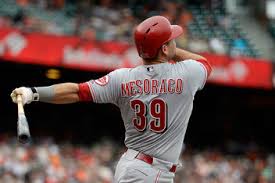 Is Devin Mesoraco set for a breakout season, replacing the putrid production that Ryan Hanigan provided in 2013? Is Todd Frazier going to post an .829 OPS, as he did in 2012, or something similar to his .721 OPS from 2013? Is Zack Cozart even worth starting anymore, given his career .680 OPS over 1,256 plate appearances? Ryan Ludwick had a nice 2012 and his 2013 was ruined due to his Opening Day shoulder injury, but was he ever worth a two-year, $15 million extension, especially when you consider it was back-loaded with an option for 2015, making him guaranteed $13 million, including his 2015 buyout? Brandon Phillips, 103 RBI or not, saw his OPS fall to .705 in 2013. Joey Votto and Jay Bruce seem like locks for success, but Bruce continues to be one of the streakiest players in all of baseball, while Votto’s patience seems to have overtaken his ability to actually produce at his 2010 MVP level ever again.
Is Devin Mesoraco set for a breakout season, replacing the putrid production that Ryan Hanigan provided in 2013? Is Todd Frazier going to post an .829 OPS, as he did in 2012, or something similar to his .721 OPS from 2013? Is Zack Cozart even worth starting anymore, given his career .680 OPS over 1,256 plate appearances? Ryan Ludwick had a nice 2012 and his 2013 was ruined due to his Opening Day shoulder injury, but was he ever worth a two-year, $15 million extension, especially when you consider it was back-loaded with an option for 2015, making him guaranteed $13 million, including his 2015 buyout? Brandon Phillips, 103 RBI or not, saw his OPS fall to .705 in 2013. Joey Votto and Jay Bruce seem like locks for success, but Bruce continues to be one of the streakiest players in all of baseball, while Votto’s patience seems to have overtaken his ability to actually produce at his 2010 MVP level ever again.
As far as the rotation, it remains pretty deep, but once you get past the top five, there are question marks. While that wouldn’t be a huge deal for most clubs, you have to remember that Johnny Cueto only had one full season and he immediately got hurt in the first game of the 2012 playoffs. Bailey, Latos, and Leake are very good options, and Tony Cingrani was impressive, even with just one good pitch, but having Wang, Francis, and nothing else as fallback options is rough, which may lead to the club rushing top prospect Robert Stephenson if there was an injury in 2014, not to mention how the rotation is going to function if Bailey leaves via free agency or Cueto’s 2015 option isn’t picked up. Who will be starting games and why don’t the Reds have options waiting like the Cardinals?
The bullpen is still built to dominate, as Aroldis Chapman is as shutdown as it gets. A full season of Sean Marshall, Jonathan Broxton, a former closer in his own right, serving as a setup man, and J.J. Hoover, Sam LeCure, Manny Parra, and Alfredo Simon rounding out the group helps the Reds bullpen look tremendous for another season…but a bullpen doesn’t have a lot of value if they aren’t protecting more leads than deficits.
The Reds haven’t been active enough. The Reds haven’t drafted enough high-ceiling talent. The Reds haven’t had enough success on the international market.
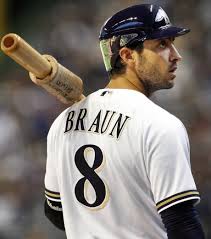 The Reds are a lot like the Milwaukee Brewers, locking up talent for just a little while, and then watching that talent and the contention window fly way in the breeze. You see, the Brewers were a competitive team until Prince Fielder left. They traded a lot of good, young talent to acquire Zack Greinke and CC Sabathia to help them contend. They bought in to that window and went for it. It is hard for a small-market to commit a lot of money to talent like Greinke and Sabathia, only to watch them leave for big-markets once they hit free agency, but the revenue that comes with a playoff run or a World Series title would alleviate a lot of those dollars. The Brewers, then, went into quite a funk the last several seasons, and they have yet to recover, but the worst part is that their farm system is terrible. If Ryan Braun doesn’t rebound, the club still has Carlos Gomez and Jean Segura, but the rest of the organization is quite barren.
The Reds are a lot like the Milwaukee Brewers, locking up talent for just a little while, and then watching that talent and the contention window fly way in the breeze. You see, the Brewers were a competitive team until Prince Fielder left. They traded a lot of good, young talent to acquire Zack Greinke and CC Sabathia to help them contend. They bought in to that window and went for it. It is hard for a small-market to commit a lot of money to talent like Greinke and Sabathia, only to watch them leave for big-markets once they hit free agency, but the revenue that comes with a playoff run or a World Series title would alleviate a lot of those dollars. The Brewers, then, went into quite a funk the last several seasons, and they have yet to recover, but the worst part is that their farm system is terrible. If Ryan Braun doesn’t rebound, the club still has Carlos Gomez and Jean Segura, but the rest of the organization is quite barren.
The Reds are a lot like the Brewers because they haven’t had many successful recent drafts. While a lot of the key names on the major league roster are homegrown, there isn’t a whole lot of depth currently in the minor league system. The Reds did trade a couple of solid young players (Yasmani Grandal, Yonder Alonso, and Brad Boxberger) to acquire Mat Latos and Choo (Didi Gregorius and Drew Stubbs), but outside of Stephenson and Hamilton, much of the high-level talent was in Low-A or the Rookie levels last season, specifically Phillip Ervin, Jesse Winker, and Nick Travieso.
So, what will happen when 2015 rolls around without an Oscar Taveras waiting to take over left field for Ludwick? Who fills the rotation without a Gerrit Cole or Jameson Taillon ready to step in for A.J. Burnett? Who will push Todd Frazier at third base without a Kris Bryant or Javier Baez?
While the Reds and Brewers have weaker farm systems and question marks at several spots, the Cubs, Cardinals, and Pirates have done it right. They have managed to stay active and have taken risks with draft picks to make sure that they are getting the talent necessary to maintain solid depth within their organization. Sure, the Pirates and Cubs have had higher picks due to their lack of success over the years, but the Cardinals have a lot of talent and they haven’t had a season below .500 since 2007, while making the playoffs in 11 of the last 18 seasons, including four World Series and two titles.
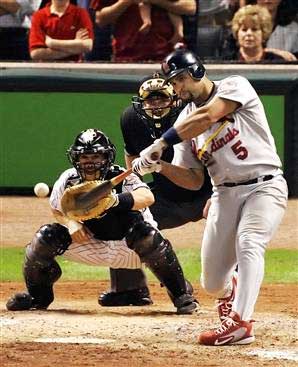 The conservative nature of the current regime in Cincinnati may not look awful as the Reds compete in 2014, but when Chicago, Pittsburgh, and St. Louis have their high-level minor league talent stepping in within the next two to three seasons, Reds fans will forget about the nightmares that Albert Pujols used to bring, and will instead be kept awake by Javier Baez, Kris Bryant, Albert Almora, Gregory Polanco, Oscar Taveras, and others who will make their names in the depths of the thriving systems in the rest of the National League Central. Meanwhile, the Brewers and Reds will continue to cry small-market when they have, instead, chosen to be smarter at the right times.
The conservative nature of the current regime in Cincinnati may not look awful as the Reds compete in 2014, but when Chicago, Pittsburgh, and St. Louis have their high-level minor league talent stepping in within the next two to three seasons, Reds fans will forget about the nightmares that Albert Pujols used to bring, and will instead be kept awake by Javier Baez, Kris Bryant, Albert Almora, Gregory Polanco, Oscar Taveras, and others who will make their names in the depths of the thriving systems in the rest of the National League Central. Meanwhile, the Brewers and Reds will continue to cry small-market when they have, instead, chosen to be smarter at the right times.
There are still names on the free agent market that can help the Reds contend, but none of them will make them as good as they were last season, in 2012, or in 2010, when Cincinnati has reached the playoffs. It doesn’t make a whole lot of sense at this point to scrap what has been built. Instead, run out there with what you have and hope for the best, which, apparently, was Walt Jocketty and Bob Castellini’s plan all offseason.


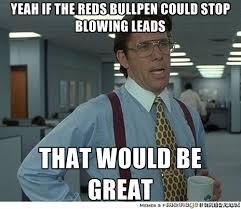 Unfortunately, the 2016 season has been hellacious for Hoover. He has faced 48 batters, allowing 16 hits, walking six of them, and giving up a whopping five homers over 10 appearances and 8.2 innings. His 15.58 ERA and 2.53 WHIP have helped pace the Cincinnati bullpen in ineptitude. The Reds’ bullpen ranks dead last in ERA by nearly a half a run (6.29) and they have given up 19 home runs in 83 innings. Even the Braves could hit home runs off of the Reds bullpen! In those 83 innings, the Reds’ bullpen has given up more home runs than eight teams entire pitching staffs.
Unfortunately, the 2016 season has been hellacious for Hoover. He has faced 48 batters, allowing 16 hits, walking six of them, and giving up a whopping five homers over 10 appearances and 8.2 innings. His 15.58 ERA and 2.53 WHIP have helped pace the Cincinnati bullpen in ineptitude. The Reds’ bullpen ranks dead last in ERA by nearly a half a run (6.29) and they have given up 19 home runs in 83 innings. Even the Braves could hit home runs off of the Reds bullpen! In those 83 innings, the Reds’ bullpen has given up more home runs than eight teams entire pitching staffs.